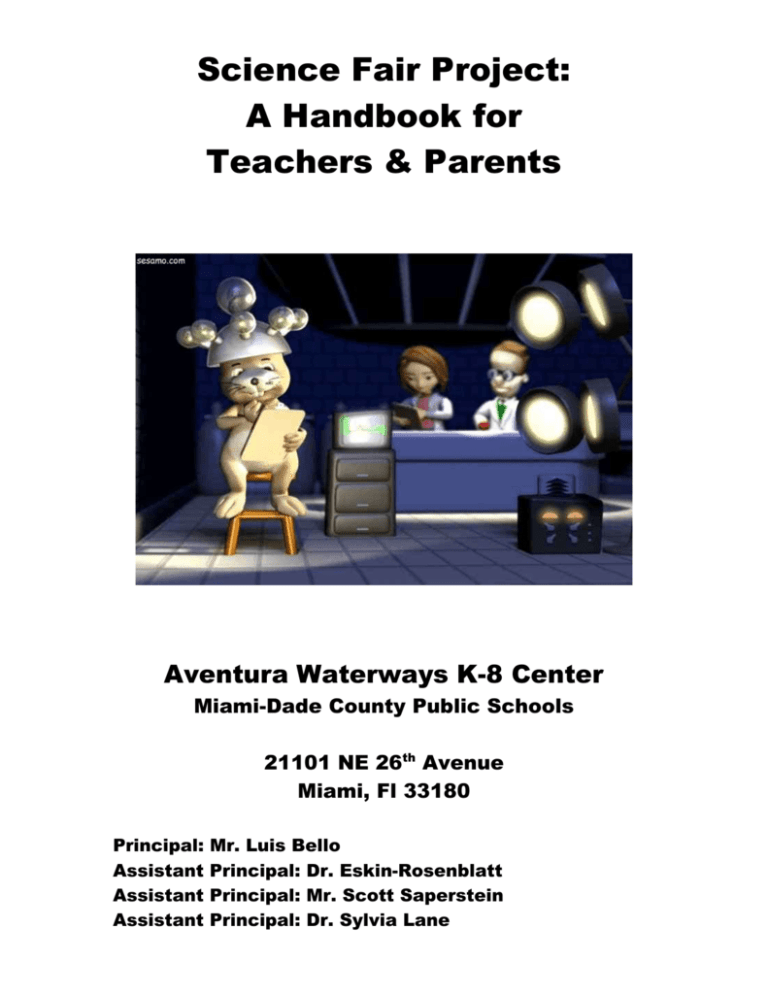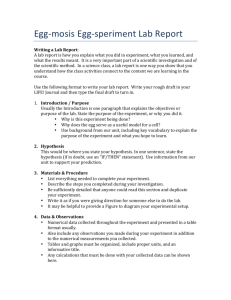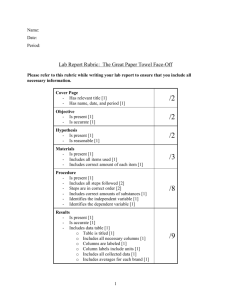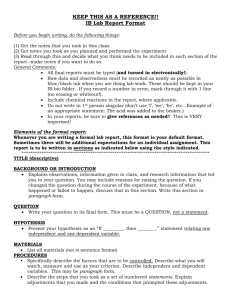Science Fair Project - Aventura Waterways K-8 Center - Miami
advertisement

Science Fair Project: A Handbook for Teachers & Parents Aventura Waterways K-8 Center Miami-Dade County Public Schools 21101 NE 26th Avenue Miami, Fl 33180 Principal: Assistant Assistant Assistant Mr. Luis Bello Principal: Dr. Eskin-Rosenblatt Principal: Mr. Scott Saperstein Principal: Dr. Sylvia Lane Schedule of Assignments Grades 3-5 individual student projects Date Due October 5, 2012 October 12, 2012 October 19, 2012 October 25, 2012 November 2, 2012 November 9, 2012 November 16, 2012 November 19-21, 2012 November 27, 2012 November 28-30, 2012 Assignment Due Problem Statement and Title Background Information, Bibliography & Hypothesis Materials, Procedures and Variables Data: Tables, Graphs and Pictures Results and Conclusion Application and Abstract Completed project on display board turned in to classroom teacher Classroom presentations to vote for one winner Teachers turn in winning class project to Media Center. Judging in the Media Center Grades K-1 one class project Grade 2 individual student projects Date Due April 26, 2013 May 3, 2013 May 10, 2013 May 17, 2013 May 24, 2013 May 28, 2013 May 29-31, 2013 Assignment Due Problem Statement and Title Background Information, Bibliography & Hypothesis Materials, Procedures and Variables, Data: Tables, Graphs and Pictures Results, Conclusion, Application, Abstract Completed project on display board turned in to classroom teacher/ Classroom presentations Teachers turn in winning class project to Media Center. Judging in the Media Center Science Fair Project Guidelines All Science Fair projects must include the following: • Title • Problem statement • Background information • Hypothesis • Materials • Procedures • Variable (manipulated, responding, held constant) control if applicable • Data - 3 types minimum (include charts, graphs, pictures, qualitative/quantitative observations, surveys, diagrams, etc.) • Results • Conclusions • Application - real world extensions; further investigations • Bibliography (minimum of 3-5 resources; all resources can not be from the Internet • Abstract - including the summary or purpose, brief and summarized procedures, results, and conclusions • Data log - a dated log of what was done on a daily basis towards finding the results of the project • Creativity - projects should be original, innovative, and creative! The following pages contain descriptions of each of the above mentioned components with examples that will help students develop their projects. Title A project needs a title. It lets people know what you have worked on. The title should be in the form of a statement. If you use the problem statement as your title, it should be in the form of a question. Consider the following: Poor title: Soap Powder (does not say enough information) Better general title: Cleaning Power of Soap Powder Problem statement as title: Which Soap Powder is the Best Cleaner of Ketchup Stains? These are some tips to help you select a title. • Read in science books, magazines, newspapers for title ideas • Talk to your teacher, family, and friends • Select a topic that interests you • Follow your curiosity; select a topic that you do not know anything about • Select a topic that you know a little about but you want to investigate further to see what will happen if... • See a list of possible project ideas included Problem Statement The problem statement is always written in the form of a question, even if it is used as the title. The question tells people what you are trying to find out. Poor problem statement: How does Soap Work? Better problem statement: Which Soap Powder Works Best in Removing Catsup Stains? Hypothesis A hypothesis states what you think is going to happen when you investigate a question. Remember to include the words If and Then to describe the manipulated, and the responding variables. Be sure to make a numerical prediction of the expected result (ex: 2 out of 3, 67%). Use third person when you write your hypothesis. (No pronouns) Here is an example: Question: Which brand of paper towels is the most absorbent? Hypothesis: If Viva, Bounty, and Suave paper towels are tested for their absorbency, then Viva paper towels will be 20 % more absorbent because Viva paper towels are thicker. Materials List all materials used in your investigation. Include what, how much, and what kinds of materials you used. Keep in mind quantities are important. Be sure to measure all your materials using metric units. Do not forget to write your numbers in words. Example of a “good listing”: 3, 15x15 cm sq. each of Brawney, Gala, Scott, generic paper towels 250 ml graduated beaker 750 ml water 20O C 1, 20x20 cm sq. cake pan Celsius thermometer clock with a second hand Procedures Your step-by-step directions are like a recipe. Anyone who reads them will be able to duplicate your investigation and get the same results. Remember the first word of each step must be written as a verb. Example: Step-by-Step Directions: 1. Cut 3, 15x15 cm sq. from each brand of paper towel 2. Label each cut piece with brand name 3. Pour 50 ml of 20O C water into 20x20 cm sq pan 4. Place 1 square of generic brand paper towel into water and pan 5. Leave for 30 seconds 6. Remove paper towel 7. Measure water remaining in pan and record 8. Dry the cake pan 9. Repeat steps 4-8 for each brand of paper towel 10. Repeat entire process twice more for each brand of paper towel Variables There are three types of variables. 1. Manipulated Variable or Independent Variable What you change on purpose in an investigation. 2. Responding Variable or Dependent Variable The responding variable is what changes by itself. 3. Variables held constant or Control Variable Everything else in your investigation must be held constant (kept the same) Example of variables: Question: Do all brands of paper towels absorb the same amount of water? Manipulated variable: brand of paper towel (what you changed on purpose) Responding variable: amount of water that is adsorbed by each towel Kept constant size of towel, temp. of water, amount of water etc. Background Information Once you have chosen your science problem it is important to research the written materials available on your subject. By finding out as much background information as you can about the subject, you will gain better understanding of your problem. This will be valuable to you as you plan your project. The following are guidelines for conducting a research: 1. Read books and articles on your subject. Make sure this information is upto-date (usually not older than five to ten years, depending on the subject.) 2. Interview and talk with people who are knowledgeable about your subject. 3. After reading books or interviewing people about your topic, write a paragraph that includes all the information that you gathered. * The background information is for the report only. It does not go on the project board. Bibliography Make a list of all the books, magazines, interviews, or other sources that were used. General Form and Examples: BOOK : Author’s last name, first name, and initial. Title of book, city of publication: publisher, year, pages used Cured, Mary B., Medicinal Plants, New York: Moorehouse and Moorehouse Publications, 199, pp. 84-86 MAGAZINE: Title of article, title of magazine, volume and number, city of publication: publisher, month, year, pages or article used. “Problem-Solving Processes,” The Science Teacher, Volume 6, Number 4, Alexandria: National Science Teachers Association, April 1999, pp 16-19 INTERVIEW: Interviewed person’s last name, first name, initial, title, type of interview, month date, year of interview, department of one interviewed, institution where the interviewed works, phone number. Brown, Joseph T. Ph.D., telephone interview, September 17, 2008, Department of Botany, Somewhere University, (555) 444-3210 ENCYCLOPEDIA: Title of article, title of encyclopedia, place of publication, the publisher, date of publication, volume number, pages used. “Seeds”, World Book, New York: World Publishers, 1999, Volume S, pages 1120-1121. WORLD WIDE WEB: Classical Muty: “The Ancient Sources.” Dept. of Greek and Roman Studies, U of Victoria. 28 Mar. 1998 <http://www.wesleyan.edu/cbays/homepage/ttlm> Data/Log Data refers to information gathered during your investigation. Writing in a spiral notebook is the most convenient way to keep a log. Your log should include: 1. A list of all the materials you use 2. Notes on all the preparation you made prior to starting your investigation 3. Information about the resources you use (books, people, libraries, museums, universities, etc.) 4. Detailed day-by day notes on the progress of your project a. What you are actually doing b. Problems you have with your investigation c. Things you would change if you were doing this investigation again. 5. Any drawings that you fell might help explain your work 6. Data that you gather from your investigation (notes, tables charts, graphs) Quantification of Data The data collected during the course of your investigation needs to be quantifiable (measurable). All measurements in your investigation must be made in metrics. Volume: milliliter (mL) 1000 mL = 1Lliter (L) Length: milliliter (mm) 10 mm = 1 cm Centimeter (cm) 100 cm = 1 m meter (m) 1000 m = 1 km kilometer (km) Mass: milligram (mg) 10 mg = 1 cg centigram (cg) 100 cg = 1 g gram (g) 1000 g = 1 kg kilogram (kg) Results Write the results of the experiment based on the information you have observed. Example: A sheet of Viva paper towel absorbed an average of 50 mL of water. A sheet of Suave paper towel absorbed an average of 36 mL of water. Conclusions Before you write your conclusions, carefully examine all your data (graphs, charts, tables). Ask yourself these questions: • Did I get the results I expected to get? If not, how were the results different? • Were there any unexpected problems or occurrences that may have affected the results of my investigation? • Did I collect sufficient data? (Were there enough trials/samples?) • Do I need to revise my original hypothesis for this project? Your conclusions should include: 1. Statement of support or non-support of the original hypothesis. 2. Description of any problems or unusual events that occurred during your investigation. 3. What you would do different next time. 4. Revised hypothesis (if data did not support your original hypothesis). Applications Importance of how the results of the experiment may be useful to others or how the knowledge gained may be used in everyday life. Example: Farmers and nursery personnel can use fertilizer to increase the rate of growth of bean plants. Abstract The abstract is a summary of the entire project written in past tense. The first paragraph includes the purpose of the experiment and the hypothesis. The second paragraph includes the procedures. The third paragraph includes the results and the conclusions. The following template might be helpful in guiding your students to write a good abstract. The problem was ________________________________________________________________. It was hypothesized that if ________________________________________________________________, then ________________________________________________________________. The procedure followed was (written in paragraph form): ________________________________________________________________ ________________________________________________________________ ________________________________________________________________. It was concluded that ________________________________________________________________ ________________________________________________________________ ________________________________________________________________. The results of the experiment (did or did not) support the hypothesis, because of ______________________________________________________. Science Fair Project Student Name:_________________________ Teacher:_______________ Assignment #1 Due Date: October 5, 2012 Please complete the following information and return to your teacher for approval. Project Title: ________________________________________________________________ Problem Statement (needs to be in the form of a question) � Approved � Not approved _______________ Parent Signature ___________ Date Science Fair Project Student Name:_________________________ Teacher:_______________ Assignment #2 Due Date: October 12, 2012 Please complete the following information and return to your teacher for approval. Project Title: Background Information Write information you have researched about your topic, use another sheet of paper if necessary. Bibliography Write which books, magazines, or other resource(s) you have used for your experiment and your background information. You must include the title of the book, the author, the publisher, the city where it was published, the year it was published and the page numbers you used. Minimum three (3) resources. � Approved � Not approved _______________ Parent Signature ___________ Date Science Fair Project Student Name:_________________________ Teacher:_______________ Assignment #2 Due Date: October 12, 2012 Please complete the following information and return to your teacher for approval. Project Title: ________________________________________________________________ Problem Statement (needs to be in the form of a question) Hypothesis � Approved � Not approved _______________ Parent Signature ___________ Date Science Fair Project Student Name:_________________________ Teacher:_______________ Assignment #3 Due Date: October 19, 2012 Please complete the following information and return to your teacher for approval. Project Title: Materials (list) Procedures (numbered step by step) 1. 2. 3. 4. 5. 6. 7. 8. 9. 10. Variables Variables held constant/Control Variable (what stays the same) Manipulated/Independent Variables (what changes) Responding/Dependent Variables (what you observe) � Approved � Not approved _______________ Parent Signature ___________ Date Science Fair Project Student Name:_________________________ Teacher:_______________ Assignment #4 Due Date: October 25, 2012 Please complete the following information and return to your teacher for approval. Project Title: Data (include tables, graphs and pictures attached to this worksheet if needed) � Approved � Not approved _______________ Parent Signature ___________ Date Science Fair Project Student Name:_________________________ Teacher:_______________ Assignment #5 Due Date: November 2, 2012 Please complete the following information and return to your teacher for approval. Project Title: Results Conclusion � Approved � Not approved _______________ Parent Signature ___________ Date Science Fair Project Student Name:_________________________ Teacher:_______________ Assignment #6 Due Date: November 9, 2012 Please complete the following information and return to your teacher for approval. Project Title: Application (How can you relate your experiment to real world experiences?) Abstract First paragraph: purpose of project and hypothesis; Second paragraph: summary of procedures; Third paragraph: results and conclusions. � Approved � Not approved _______________ Parent Signature ___________ Date Name:_____________________ Science Fair Project Judging Sheet Section 1: 20 points total ________ Scientific Title (3) Problem Statement (3): What is the effect of ____on____? Hypothesis (4): Followed format; it is hypothesized that if ____then____. Abstract (10): Followed format given; 1st paragraph includes purpose of project and hypothesis; 2nd paragraph includes summary of procedures; 3rd paragraph includes results and conclusions. Section 2: 15 points total ________ Materials (3): Specific with measurements Procedures (3): Specific steps for trials Independent Variable (3): What changes in the experiment? Dependent Variable (3): What is being observed in the experiment? Control Variable/Constants (3): What stays the same in the experiment? Section 3: 27 points total ________ Table/Chart (9): Title, units, trials, mean Graphs (9): Title, axis labeled, units Pictures (9): Relevant to project, labeled Section 4: 38 points total ________ Results (10): Discuss findings, discuss numbers obtained Conclusion (10): Discuss findings and agree or disagree with hypothesis Application (3): What use does this project have in real life? Neatness (15): Creative, clean, nice effort shown on set up. Total Points (out of 100) ________ Comments: __________________________________________________________________________ __________________________________________________________________________ __________________________________________________________________________ Helpful Websites http://www.scienceproject.com http://www.cdli.ca/sciencefairs http://www.all-science-fair-projects.com http://www.biology.about.com http://www.factmonster.com http://www.elmers.com http://www.chem4kids.com http://www.madsci.org/libs/areas/reagents.html http://www.scifair.org http://www.sciencepage.org/scifair.htm http://sciencefairproject.virtualave.net http://www.sciencebob.com/lab/sciencefair/resources.html http://www.istf.ucf.edu








